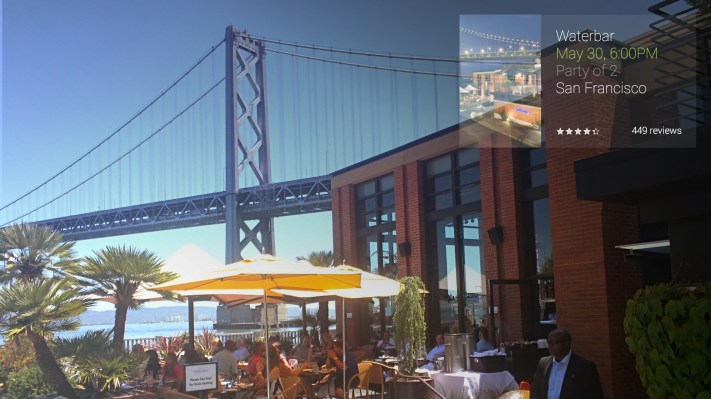A day after Google announced that it will sell Google Glass to anyone in the United States, the company is unveiling some new “Glassware” (basically, Google Glass apps) that’s supposed to be particularly useful for travelers.
This isn’t the first travel-related Glassware. The company announced Word Lens for Glass last fall, so if you saw a sign written a language that you didn’t understand, Word Lens could superimpose the translated text, as if you were reading a sign in your native language. (Even though Word Lens isn’t brand new, I got to try it out today and it was really cool.) Plus, the new Glassware isn’t only useful when you’re traveling — you might just want to find a restaurant near your house.
Nonetheless, the company seems to be making a concerted push around travel with today’s releases. It’s even asking Glass owners (“Explorers”) to share photos and videos they record while abroad with the hashtag #travelthroughglass.
Today’s three main additions are Glassware from TripIt, Foursquare, and OpenTable. Once you’ve connected your TripIt account to your device, Glass will add live cards with your flight information to your timeline — so you don’t even need to open a TripIt app to see the info. (Google already provided some of this data through Google Now, but TripIt usually has more detailed information.)
With the Foursquare integration, you can also say that you want to check in, and Glass will allow you to swipe through a list of nearby locations. (Foursquare itself has said that it’s splitting into two apps, and expanding beyond manual check ins with constant, ambient location sharing.) Similarly, you can now use Glass to browse nearby restaurants and make reservations through OpenTable. If you’ve made reservations before, Glass will automatically bring your most recent one up, though you can also change things manually. (That’s OpenTable in the image above.)
Developer Advocate Timothy Jordan and Glass Guide Soji Ojugbele gave me a quick demo of the new features, and the whole thing probably took 20 minutes. (It probably would have been even briefer if I wasn’t a relative Glass newbie, and if we didn’t occasionally have to swap devices to find one with the proper Glassware installed.) Jordan said that’s intentional — these should be quick, intuitive interactions.
Jordan also argued that the new Glassware furthers the mission of removing barriers between you and your technology. For example, if you enter at a bar, you no longer have to tell your friends to wait for a minute while you whip out your phone and check in (though you may still want to wait until you’re not mid-conversation or halfway through ordering a drink from the bartender). And if you’re at the airport running late for a flight, you don’t have to stop walking (or sprinting) in order to look up your gate number.
You can read a little more about Google’s perspective on today’s announcements here.
By the way, if you do travel with Glass this summer, it probably wouldn’t hurt to have a little refresher on the not-entirely-positive feelings about the device and how not to be a glasshole.
